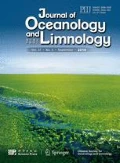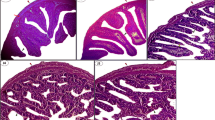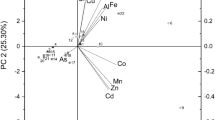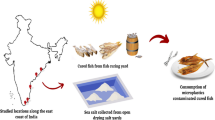Abstract
Considering the economic importance in traditional Chinese medicine (TCM) and lack of baseline information, we evaluated the proximate composition, fatty acid and amino acid profiles, trace element content and C:N ratio in the alligator pipefish, Syngnathoides biaculeatus. Amongst proximate principals, a crude protein formed the major biochemical component ((58.9±2.2)% dry weight). Mean percent concentrations (dry weight) of other components such as a total lipid (TL), ash and nitrogen-free extract measured were, (1.8±0.2)%, (19.2±2.2)% and (20.1±0.45)%, respectively. The fatty acid profile revealed the presence of 27 saturated fatty acids (SFA) with 13 straight-chained and 14 branched-chained, 28 unsaturated fatty acids (UFA) with 14 monounsaturated and 14 polyunsaturated and nine other minor fatty acids. Mean percent contributions of total SFAs and UFAs to TL were found to be (55.41±0.24)% and (44.05±0.25)%, respectively. Altogether, 16 different amino acids with an equal number of essential (EAA) and non-essential (NAA) ones were identified. Percent contributions by EAA and NAA to the total amino acid content were 38.11% and 61.89%, respectively. Trace metal concentrations in S. biaculeatus were generally low and their distribution followed the order, Mg>Fe>Zn>Mn>Cu>Cr>Ni>Hg>Co. The C:N ratio was (4.37±0.04)%. The profile of major biochemical constituents in alligator pipefish, S. biaculeatus revealed its potential use in TCM as well as a nutritional diet for human consumption. The results of the study would also form the basis for formulation and optimization of diets for the culture of S. biaculeatus.
Similar content being viewed by others
References
Alves R R N, Rosa I L. 2006. From cnidarians to mammals: the use of animals as remedies in fishing communities in NE Brazil. Journal of Ethnopharmacology, 107 (2): 259–276, http://dx.doi.org/10.1016/j.jep.2006.03.007.
AOAC. 2005). Official Methods of Analysis of the Association of Official Analytical Chemists (AOAC) International. 18 th edn. Gaithersburg, Maryland, USA.
Barrows A P W, Martin-Smith K M, Baine M S P. 2009. Population variables and life-history characteristics of the alligator pipefish Syngnathoides biaculeatus, in Papua New Guinea. Journal of Fish Biology, 74 (4): 806–819, http://dx.doi.org/10.1111/j.1095-8649.2008.02158.x.
Bartnik S Morgan, Pogonoski J, Pollard D, Paxton J. 2008. Syngnathoides biaculeatus. The IUCN Red List of Threatened Species 2008: e.T40715A10357159. http://dx.doi.org/10.2305/IUCN.UK.2008.RLTS.T40715A10357159. en. Assessed on 2015-04-16.
Bowen H J M. 1966). Trace Elements in Biochemistry. Academic Press, London. 241p.
Chyun J H, Griminger P. 1984. Improvement of nitrogen retention by arginine and glycine supplementation and its relation to collagen synthesis in traumatized mature and aged rats. Journal of Nutrition, 114 (9): 1697–1704.
Conner W E. 1997. The beneficial effects of omega-3 fatty acids: cardiovascular disease and neuro development. Current Opinion in Lipidology, 8 (1): 1–3.
Dawson C E. 1985). Indo-Pacific Pipefishes: Red Sea to the Americas. Gulf Coast Research Laboratory, Ocean Springs, MS.
Fagan K A, Koops M A, Arts M T, Power M. 2011. Assessing the utility of C: N ratios for predicting lipid content in fishes. Canadian Journal of Fisheries and Aquatic Sciences, 68 (2): 374–385, http://dx.doi.org/10.1139/F10-119.
Folch J, Less M, Sloane Stanley G H. 1957. A simple method for the isolation and purification of total lipids from animal tissues. The Journal of Biological Chemistry, 226 (1): 497–509.
Garcia A M, Geraldi R M, Vieira J P. 2005. Diet composition and feeding strategy of the southern pipefish, Syngnathus folletti in a Widgeon grass bed of the Patos Lagoon Estuary, RS, Brazil. Neotropical Ichthyology, 3 (3): 427–432, http://dx.doi.org/10.1590/S1679-62252005000300011.
Gibson R A. 1983. Australian fish-an excellent source of both arachidonic acid and 3 polyunsaturated fatty acids. Lipids, 18 (11): 743–752, http://dx.doi.org/10.1007/BF02534631.
Harris R K, Nishiyama T, Paul A J. 1986. Carbon, nitrogen and caloric content of eggs, larvae, and juveniles of the walleye pollock, Theragra chalcogramma. Journal of Fish Biology, 29 (1): 87–98, http://dx.doi.org/10.1111/j.1095-8649.1986.tb04928.x.
Heimann W. 1980). Fundamentals of Food Chemistry. AVI Publishing Company, Westport, Connecticut, USA. 344p.
Henderson R J, Tocher D R. 1987. The lipid composition and biochemistry of freshwater fish. Progress in Lipid Research, 26 (4): 281–347.
Hibbeln J R, Nieminen L R, Blasbalg T L, Riggs J A, Lands W E. 2006. Healthy intakes of n-3 and n-6 fatty acids: estimations considering worldwide diversity. The American Journal of Clinical Nutrition, 83 (6): S1483–S1493.
Hung Y L, Hwang P A, Gau S Y, Wu C H. 2008. Antioxidative and Immune activities of Hippocampus kuda extract. Journal of Taiwan Fisheries Research, 16 (2): 97–105. (in Chinese with English abstract)
Kumaravel K, Ravichandran S, Balasubramanian T, Sonneschein L. 2012. Seahorses-A source of traditional medicine. Natural Product Research, 26 (24): 2330–2334, http://dx.doi.org/10.1080/14786419.2012.662650.
Larsson S C. 2013. Dietary fats and other nutrients on stroke. Current Opinion in Lipidology, 24 (1): 41–48, http://dx. doi.org/10.1097/MOL.0b013e3283592eea.
Lin Q, Lin J D, Lu J Y, Li B J. 2008. Biochemical composition of six seahorse species, Hippocampus sp. from the Chinese Coast. Journal of the World Aquaculture Society, 39 (2): 225–234, http://dx.doi.org/10.1111/j.1749-7345.2008.00159.x.
Lin Q, Lin J D, Wang C. 2009. Biochemical composition of the wild and cultured seahorses, Hippocampus kuda Bleeker and Hippocampus trimaculatus Leach. Aquaculture Research, 40 (6): 710–719, http://dx.doi.org/10.1111/j.1365-2109.2008.02149.x.
Lv J Y, Li B J, Sun Y Y, Yang D W, Huang K. 2002. The ingestion, growth and ecological conversion efficiency of Hippocampus kuda under the intensive rearing conditions. Journal of Fisheries of China, 26 (1): 61–66. (in Chinese with English abstract)
Martinez-Cardenas L, Sumaya-Martínez M T, Valdez-Hernández E F, González-Díaz A A, Soria-Barreto M, Castañeda-Chavez M R, Ruiz-Velazco J M, Peña-Messina E. 2013. Effect of Temperature on growth and survival in juvenile Opossum pipefish, Microphis brachyurus: first observations on the species in culture conditions. Journal of the World Aquaculture Society, 44 (5): 735–742, http://dx.doi.org/10.1111/jwas.12063.
Martin-Smith K M, Lam T F, Lee S K. 2003. Trade in pipehorses, Solegnathus spp. for traditional medicine in Hong Kong. TRAFFIC Bulletin, 19 (3): 139–148.
Martin-Smith K M, Vincent A C J. 2006. Exploitation and trade of Australian seahorses, pipehorses, sea dragons and pipefishes (family Syngnathidae). Oryx, 40 (2): 141–151, http://dx.doi.org/10.1017/S003060530600010x.
Mat Jais A M, McCulloh R, Croft K. 1994. Fatty acid and amino acid composition in haruan as a potential role in wound healing. General Pharmacology, 25 (5): 947–950.
Mazereeuw G, Lanctôt K L, Chau S A, Swardfager W, Herrmann N. 2012. Effects of omega-3 fatty acids on cognitive performance: a meta-analysis. Neurobiology of Aging, 33 (7): 1482.e17–1482.e29, http://dx.doi.org/10.1016/j.neurobiolaging.2011.12.014.
Meng X Q, Xu D H, Mei X T, Xu S B, Lv J Y, Li B J. 2005. Research on Hippocampus capsule therapy of experimental benign prostatic hyperplasia. Chinese Pharmaceutical Journal, 40 (3): 190–193. (in Chinese with English abstract)
Moreau M A, Hall H J, Vincent A C J. 1998). Proceedings of the First International Workshop on The Management and Culture of Marine Species Used in Traditional Medicines. Project Seahorse, Montreal, Canada.
Morris C A, Haynes K C, Keeton J T, Gatlin D M. 1995. Fish oil dietary effects on fatty acid composition and flavor of channel catfish. Journal of Food Science, 60 (6): 1225–1227, http://dx.doi.org/10.1111/j.1365-2621.1995.tb04561.x.
Murugan A, Dhanya S, Sreepada R A, Rajagopal S, Balasubramanian T. 2009. Breeding and mass-scale rearing of three spotted seahorse, Hippocampus trimaculatus Leach under captive conditions. Aquaculture, 290 (1-2): 87–96,http://dx.doi.org/10.1016/j.aquaculture.2009.01.033.
Orban E, Nevigato T, Masci M, Di Lena G, Casini I, Caproni R, Gambelli L, De Angelis P, Rampacci M. 2007. Nutritional quality and safety of European perch (Perca fluviatilis) from three lakes of central Italy. Food Chemistry, 100 (2): 482–490, http://dx.doi.org/10.1016/j.foodchem.2005.09.069.
Osman H, Suriah A R, Law E C. 2001. Fatty acid composition and cholesterol content of selected marine fish in Malaysian waters. Food Chemistry, 73 (1): 55–60, http://dx.doi.org/10.1016/S0308-8146(00)00277-6.
Payne M F, Rippingale R J. 2000. Rearing West Australian seahorse, Hippocampus subelongatus juveniles on copepod nauplii and enriched Artemia. Aquaculture, 188 (3-4): 353–361, http://dx.doi.org/10.1016/S0044-8486(00)00349-5.
Perumal P, Rajkumar M, Santhanam P. 2009. Biochemical composition of wild copepods, Acartia spinicauda and Oithona similis, from Parangipettai coastal waters in relation to environmental parameters. Journal of Environmental Biology, 30 (6): 995–1005.
Pogonoski J J, Pollard D A, Paxton J R. 2002). Conservation overview and action plan for Australian threatened and potentially threatened marine and estuarine fishes. Environment Australia, Canberra, Australia.
Qian Z J, Kang K H, Kim S K. 2012. Isolation and antioxidant activity evaluation of two new phthalate derivatives from seahorse, Hippocampus kuda Bleeker. Biotechnology and Bioprocess Engineering, 17 (5): 1031–1040, http://dx.doi.org/10.1007/s12257-012-0115-1.
Qian Z J, Ryu B, Kim M M, Kim S K. 2008. Free radical and reactive oxygen species scavenging activities of the extracts from seahorse, Hippocampus kuda Bleeker. Biotechnology and Bioprocess Engineering, 13 (6): 705–715, http://dx.doi.org/10.1007/s12257-008-0093-5.
Rethna Priya E, Ravichandran S, Ezhilmathi R. 2013. Bioactive proteins from pipefishes. Journal of Coastal Life Medicine, 1 (1): 1–5, http://dx.doi.org/10.12980/JCLM.1.2013C384.
Rosa I L, Defavari G R, Alves R R N, Oliveira T P R. 2013). Seahorses in traditional medicines: a global review. In: Alves R R N, Rosa I L eds. Animals in Traditional Folk Medicine. Springer-Verlag, Berlin Heidelberg. p.207–240, http://dx.doi.org/10.1007/978-3-642-29026-8-10.
Sanaye S V, Pise N M, Pawar A P, Parab P P, Sreepada R A, Pawar H B, Revankar A D. 2014. Evaluation of antioxidant activities in captive-bred cultured yellow seahorse, Hippocampus kuda (Bleeker, 1852). Aquaculture, 434: 100–107, http://dx.doi.org/10.1016/j.aquaculture.2014.08.007.
Sanaye S V, Pise N M, Pawar A P, Parab P P, Sreepada R A, Pawar H B, Murugan A. 2015. Total phenolic content and in -vitro antioxidant activities from methanolic extract of alligator pipefish, Syngnathoides biaculeatus (Bloch, 1785). Indian Journal of Geo -Marine Sciences, 44 (9): 1352–1357.
Shi R C, Yao L X, Bei X F, Zhu J P, Wang J. 2006. Chinese medicine rehabilitative therapy for periarthritis of shoulder. Chinese Journal of Clinical Rehabilitation, 10 (47): 150–152. (in Chinese with English abstract)
Shi R, Zhang Y H, Wang Z G. 1993). Experimental studies on Hailong extracts from Syngnathoides biaculeatus. 1. The influences of Hailong extracts on human PBL proliferation and human tumor cell lines. Chinese Journal of Marine Drugs, (2): 4–6. (in Chinese)
Simopoulos A P. 2006. Evolutionary aspects of diet, the omega-6/omega-3 ratio and genetic variation: nutritional implications for chronic diseases. Biomedicine & Pharmacotherapy, 60 (9): 502–507, http://dx.doi.org/10.1016/j.biopha.2006.07.080.
Spitz J, Mourocq E, Schoen V, Ridoux V. 2010). Proximate composition and energy content of forage species from the Bay of Biscay: high-or low-quality food? ICES Journal of Marine Science, 67 (5): 909–915, http://dx.doi.org/10.1093/icesjms/fsq008.
Sreepada R A, Desai U M, Naik S. 2002. The plight of Indian seahorses: need for conservation and management. Current Science, 82 (4): 377–378.
Tipton K, Bell S S. 1988. Foraging patterns of two syngnathid fishes: importance of harpacticoid copepods. Marine Ecology Progress Series, 47: 31–43.
Vincent A C J. 1995. Exploitation of seahorses and pipefishes. NAGA, the ICLARM Quarterly, 18 (1): 18–19.
Vincent A C J. 1996). The international trade in seahorse. TRAFFIC International Cambridge, UK. 172p.
Wijesekara I, Qian Z J, Ryu B, Ngo D H, Kim S K. 2011. Purification and identification of antihypertensive peptide from seaweed pipefish (Syngnathus schlegeli) muscle protein hydrolysate. Food Research International, 44 (3): 703–707, http://dx.doi.org/10.1016/j.foodres.2010.12.022.
Witte M B, Thornton F J, Tantry U, Barbul A. 2002. L-Arginine supplementation enhances diabetic wound healing: involvement of the nitric oxide synthase and arginase pathways. Metabolism, 51 (10): 1269–1273, http://dx.doi.org/10.1053/meta.2002.35185.
Wood J D, Richardson R I, Nute G R, Fisher A V, Campo M M, Kasapidou E, Sheard P R, Enser M. 2004. Effects of fatty acids on meat quality: a review. Meat Science, 66 (1): 21–32, http://dx.doi.org/10.1016/S0309-1740(03)00022-6.
Woods A E, Aurand L W. 1977). Laboratory Manual in Food Chemistry. The AVI Publishing Company, Inc., Westport, CT. 77p.
Wu G Y. 2009. Amino acids: metabolism, functions, and nutrition. Amino Acids, 37 (1): 1–17, http://dx.doi.org/10.1007/s00726-009-0269-0.
Xu D H, Mei X T, Li B J, Lin Z L, Xu S B. 2003. The pharmacological effects of Hippocampus capsule on enhancing sexual functions of rats. Journal of Chinese Medicinal Materials, 26 (11): 807–808. (in Chinese with English abstract)
Zhang C H, Ni Q G, Wu L Y, Wang Q, Xu L S, Xu G J. 1998. Studies on antitumor activity of Trachyrhamphus serratus. Chinese Journal of Marine Drugs, 4): 10–12. (in Chinese with English abstract)
Zhang N, Xu B, Mou C Y, Yang W L, Wei J W, Lu L, Zhu J J, Du J C, Wu X K, Ye L T, Fu Z Y, Lu Y, Lin J H, Sun Z Z, Su J, Dong M L, Xu A L. 2003. Molecular profile of the unique species of traditional Chinese medicine, Chinese seahorse (Hippocampus kuda Bleeker). FEBS Letters, 550 (1-3): 124–134, http://dx.doi.org/10.1016/S0014-5793(03)00855-X.
Zuraini A, Somchit M N, Solihah M H, Goh Y M, Arifah A K, Zakaria M S, Somchit N, Rajion M A, Zakaria Z A, Mat Jais A M. 2006. Fatty acid and amino acid composition of three local Malaysian Channa spp. fish. Food Chemistry, 97 (4): 674–678, http://dx.doi.org/10.1016/j.foodchem.2005.04.031.
Acknowledgement
The authors are grateful to the Director, CSIR-National Institute of Oceanography, Goa (India) for encouragement and facilities. Permission granted by Chief Wildlife Warden, Forest department, Govt. of Tamil Nadu (India) for the collection of alligator pipefi shes from Mullimunnai village, Palk Bay is gratefully acknowledged. This represents contribution No. 5939 of the CSIR-National Institute of Oceanography, Goa (India).
Author information
Authors and Affiliations
Corresponding author
Rights and permissions
About this article
Cite this article
Sanaye, S.V., Pawar, A.P., Rivonker, C.U. et al. Biochemical composition of the alligator pipefish, Syngnathoides biaculeatus (Bloch, 1785). Chin. J. Ocean. Limnol. 35, 1501–1510 (2017). https://doi.org/10.1007/s00343-017-6070-0
Received:
Accepted:
Published:
Issue Date:
DOI: https://doi.org/10.1007/s00343-017-6070-0




